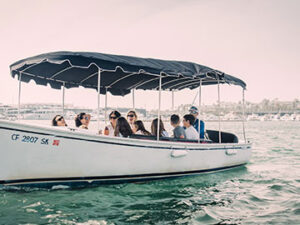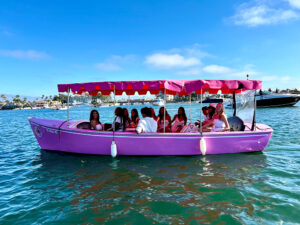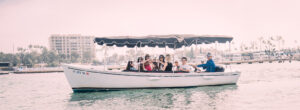Introduction
Photographing the dynamic and ever-changing seascapes of Newport Beach from the deck of a boat offers a unique perspective not commonly captured from the shore. The freedom to navigate the waters provides photographers with unparalleled angles and vistas, capturing the essence of the coastline and its marine environment. This form of photography not only demands skill and creativity but also an adventurous spirit to seek out and immortalize those perfect moments of natural beauty.
Boats provide a versatile platform for photographers to explore and document the diverse landscapes, from serene early morning waters to vibrant sunset horizons. This guide will delve into the essentials of marine photography, covering everything from the technical aspects of camera settings to the artistic considerations of composition and light. Whether you’re a seasoned photographer or a hobbyist looking to expand your portfolio, photographing from a boat can add a new dimension to your photographic endeavors.
The following sections will outline the best practices and tips for capturing stunning seascapes and marine life, ensuring that each photograph reflects the beauty and unique character of Newport Beach. From preparing your equipment to post-processing your images, this article will provide you with the knowledge and inspiration needed to make the most of your photographic journey on the water.
Understanding the Basics of Marine Photography
Marine photography presents unique challenges and opportunities that differ significantly from land-based photography. Understanding the basic principles such as the impact of light reflection off water, the movement of your boat, and the saltwater environment on your equipment is crucial. Optimal camera settings for marine photography typically involve faster shutter speeds to capture clear images of moving subjects and the undulating sea, a higher ISO for conditions with varying light, and a smaller aperture to ensure a wide depth of field.
Another critical aspect is the ability to anticipate and react to changing light conditions. Early morning and late afternoon are ideal for softer light and dramatic skies, but midday light can be harsh and direct. Utilizing polarizing filters can help reduce glare from the water and enhance the blues of the sky and sea, making your images pop with color and contrast.
It’s also essential to continuously monitor weather conditions. Marine environments can change rapidly, and understanding how weather affects sea conditions and lighting can help you plan your shoots more effectively. Always have a backup plan in case of sudden weather changes, and ensure your safety and that of your equipment by being prepared for any situation.
Choosing the Right Equipment
Selecting the right equipment is fundamental in marine photography. A durable and high-quality camera with a fast autofocus system and good high ISO performance is crucial due to the often fast-paced and unpredictable nature of the sea. DSLR or mirrorless cameras with weather-sealing are preferred for their resilience against harsh marine conditions. Lenses should also be chosen based on the type of photography you intend to pursue; a telephoto lens is great for wildlife and distant subjects, while a wide-angle lens can capture expansive seascapes.
Given the challenging environment of marine photography, protecting your equipment is paramount. Waterproof or water-resistant camera bags, protective housings, and UV filters can safeguard your gear against saltwater and spray. Additionally, having a sturdy tripod or a gimbal stabilizer can help in maintaining the stability of your camera during the shoot, crucial for achieving sharp images on a moving boat.
Lastly, do not underestimate the power of simple accessories like a lens cleaning kit and a protective cover for your camera and lens. Salt spray is a common issue on the water and can damage your equipment if not cleaned properly. Regular maintenance and proper storage of your photography gear will extend its lifespan and performance in these tough conditions.
Preparation and Planning
Successful marine photography begins long before you set foot on a boat. Preparation is key to ensuring a productive shooting day. Start by researching the best times and locations for the types of images you want to capture. Understanding the local marine life’s behaviors and the area’s geographical features can help you predict where and when to find interesting subjects or backdrops.
Packing the right gear is also essential. Apart from your camera and lenses, include plenty of batteries, memory cards, and a cleaning kit. Clothes and personal items should be suitable for the wet and potentially changeable conditions on the boat. Waterproof clothing, non-slip shoes, and sun protection are must-haves.
Plan your route based on the day’s weather forecast and tide tables. Consult with local boaters or photographers who are familiar with the area to get insights into hidden spots or advice on handling specific local challenges. The more detailed your planning, the better equipped you’ll be to handle the unpredictable nature of the sea and to focus on capturing great images.
Composing Shots from a Moving Platform
Composing photographs from a moving boat requires a different approach compared to shooting from solid ground. The constant movement can be challenging, but it also offers unique opportunities for dynamic compositions. Practicing the panning technique, where you move the camera along with the moving subject, can result in sharp subjects against a smoothly blurred background, conveying a sense of speed and motion.
To stabilize your shots, use a fast shutter speed to freeze motion, and consider using burst mode to increase your chances of capturing the perfect moment. A gimbal or a stabilizer can also be highly beneficial in counteracting the boat’s movement, especially when using longer focal lengths. Always be aware of your footing and balance on the boat, as safety should never be compromised for the sake of a photo.
When composing your shots, consider the rule of thirds to create a balanced image, and try to incorporate leading lines or framing elements that can add depth to your photos. The horizon line is a crucial element in seascape photography; keeping it straight is essential unless a tilted angle adds to the artistic intent of the shot. Always be ready to adapt your composition as new elements come into view or as lighting conditions change.
Capturing the Golden Hours
The golden hours, during sunrise and sunset, are particularly magical times for photography, especially on the water. The soft, diffused light and the colorful skies create a spectacular backdrop for seascapes. Planning your shoot around these times can significantly enhance the quality and mood of your photos. Check the exact times for sunrise and sunset and plan to be in your chosen location well in advance to set up and be ready when the light is at its best.
During these hours, the angle of the sun casts long shadows and highlights textures, which can add depth and interest to your images. Use a graduated neutral density filter to balance the exposure between the bright sky and the darker sea. This can prevent the sky from being overexposed while maintaining detail in the water and landscape.
Be prepared to work quickly during these fleeting moments. The light conditions can change rapidly, so having your camera set up and ready is crucial. Experiment with different exposures and compositions to capture a variety of shots. The reflection of the sun on the water can also create stunning effects, so be on the lookout for opportunities to use the water’s surface as a mirror or to capture silhouettes against the glowing sky.
High-Speed Photography on Water
Capturing fast-moving subjects on water, such as birds diving for fish, dolphins playing in the boat’s wake, or surfers riding waves, requires high-speed photography techniques. A fast shutter speed is crucial to freeze motion and maintain sharpness in your images. Start with a shutter speed of at least 1/1000th of a second and adjust according to the speed of your subject.
Using continuous autofocus (AF-C or AI Servo AF mode) will help your camera maintain focus on moving subjects. It’s also advisable to use continuous or burst shooting mode to capture multiple frames per second, increasing your chances of getting the perfect shot amidst rapid action. Position yourself in a stable manner on the boat, possibly seated to lower your center of gravity, and use the boat’s sides or your knees as support for your elbows to minimize camera shake.
Be mindful of the lighting conditions and adjust your ISO settings accordingly. In bright conditions, you may not need a high ISO, but in lower light, increasing the ISO can help maintain faster shutter speeds without compromising exposure. However, be aware of the increased noise levels at high ISO settings and balance this with the need for speed and sharpness in your shots.
Panoramic Seascapes and Wide-Angle Shots
Wide-angle lenses are perfect for capturing the expansive nature of seascapes from a boat. They allow you to include more of the scene, giving a sense of scale and grandeur to your images. When shooting wide, consider incorporating elements of the boat in the foreground to add interest and context to the scene. This could be the deck, a part of the railing, or any equipment that tells a story of your day on the water.
Panoramic shots can also be stunning when taken from a boat, as they can capture the vastness of the sea and sky. Most modern cameras have a panoramic shooting mode, or you can create panoramas in post-processing by stitching together several overlapping images. When shooting for panoramas, ensure each frame overlaps the previous one by about 30%, and keep the exposure settings consistent across shots to simplify the stitching process.
When using wide-angle lenses, be mindful of distortion, which can warp straight lines near the edges of your frame. This effect can be used creatively or corrected during post-processing. Additionally, try to keep the horizon line straight to avoid a sloping sea, which can disorient the viewer. Experiment with different heights and angles to find the most compelling way to convey the vast, open atmosphere of the seascape.
Post-Processing Marine Photography
Post-processing is a crucial step in marine photography, allowing you to enhance colors, adjust contrasts, and fine-tune details. Begin with basic adjustments such as correcting exposure and white balance to reflect the true colors of the scene. Enhancing the blues of the sky and water can often make your images more vibrant and appealing.
Use tools like the gradient filter in Lightroom to selectively adjust exposure and color in the sky and sea. This can help in creating a more balanced composition, especially in situations where the sky is much brighter than the water. Sharpening the details of waves, boats, and distant objects helps to draw the viewer’s eye and adds depth to your photos.
Consider creative edits such as converting images to black and white to focus on textures and contrasts without the distraction of color. This can be particularly effective for moody or stormy sea scenes. Always save your edits in non-destructive formats and keep original files intact, allowing you to revisit and re-edit photos in the future as your skills and style evolve.
Sharing and Showcasing Your Work
Once you have a collection of stunning seascape images, sharing them effectively can help you reach a wider audience and even open up opportunities for professional growth. Start by selecting your best images to showcase. Quality over quantity is key here; choose photos that best represent your style and the story you want to tell.
Social media platforms like Instagram, Facebook, and photography-focused sites like 500px are excellent for sharing your work. Use relevant hashtags, engage with other marine photographers, and participate in groups or forums that focus on seascape and marine photography. This can increase your visibility and connect you with potential collaborators or clients.
For those looking to display their work offline, consider printing your photos for exhibitions or selling them as fine art prints. High-quality prints can significantly impact viewers and serve as a lasting reminder of the beauty of Newport Beach’s seascapes. Be sure to use archival quality papers and inks to ensure the longevity of your prints, and consider different presentation styles, such as framed or canvas prints, to best suit your work and your audience.
By following this comprehensive guide to photographing Newport Beach from a boat, you will not only enhance your skills as a photographer but also capture the sublime beauty of the ocean in a way that truly resonates with viewers, both online and in print. Each photograph, a testament to the breathtaking landscapes and vibrant marine life of Newport Beach, will stand as a unique piece of art, inviting others to appreciate and preserve the beauty of our seas.
Conclusion
Embarking on a photographic journey across the waters of Newport Beach offers more than just an opportunity to capture stunning visuals; it’s an immersive experience that deepens one’s appreciation for the natural beauty and diversity of the marine environment. With a pontoon boat as your mobile studio, you gain unique access to expansive seascapes, dynamic wildlife, and serene moments that are often hidden from the shore-bound eye.
The tips and techniques discussed in this article will help you prepare adequately, utilize the right equipment, and master the art of marine photography to ensure that every image captured not only tells a story but also showcases the profound beauty of Newport Beach. From the golden light of sunrise to the dramatic colors of sunset, each photograph holds the potential to convey the enchanting allure of the sea.
Whether you are sharing your photographs with a broad audience online or displaying them in galleries, the images you create will serve as a window to the captivating marine world of Newport Beach. They invite viewers to experience, if only vicariously, the joy of a day spent at sea and the serene beauty that lies just beyond the bustling beachfronts. As you continue to explore and photograph this splendid locale, let each shot reflect your unique perspective and artistic vision, further enriching the collective appreciation of our precious marine landscapes.
Excited for an adventure with us or have a question? Call us at: (949) 675-8433 Book Your Ride with us: Click here to Book




